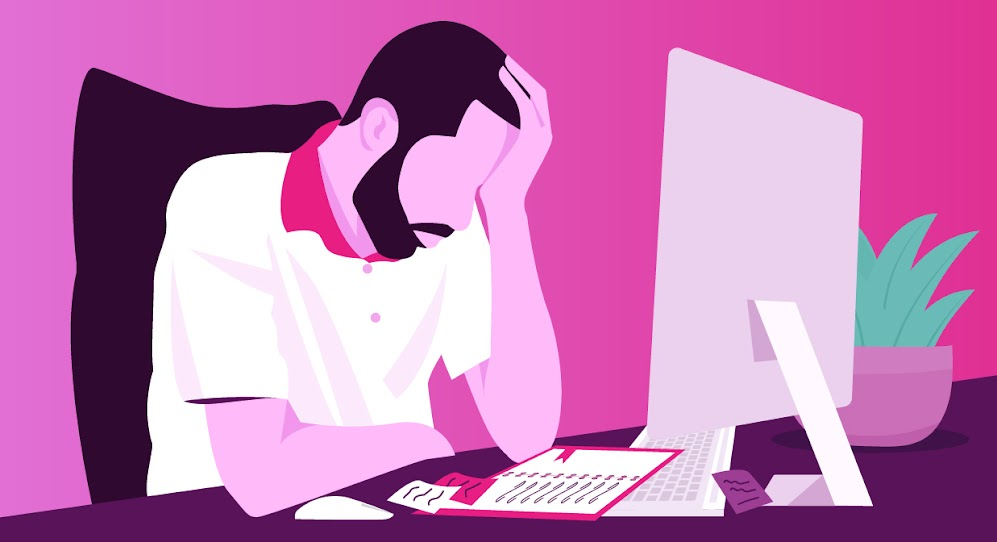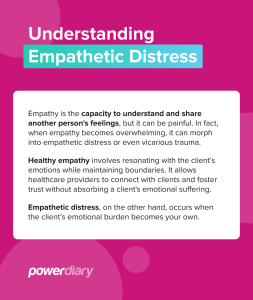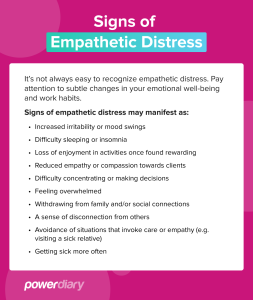As any allied health worker will know, empathy is the ability to step into another’s shoes – to feel what the client feels and respond with understanding and compassion. Empathy isn’t just a soft skill – it’s the heartbeat of therapeutic practice.
Yet, employing this essential skill has pitfalls, including empathetic distress.
Picture this: you’re increasingly attuned to your client’s struggles, and gradually, their pain becomes your own; suddenly, the weight of their experience bears down on you as if it’s your weight to carry.
This state of distress can seep into the minds of caregivers surprisingly easily, leaving them vulnerable to emotional exhaustion and burnout.
Neglecting empathetic distress can take you down a path toward professional and personal depletion.
In this article, we’ll explore the delicate balance of healthy empathy in allied healthcare. We’ll explore the nuances of empathetic distress, its potential impact on caregivers and the importance of addressing it head-on.
Understanding Empathic Distress
Empathy is the capacity to understand and share another person’s feelings, but it can be painful. In fact, when empathy becomes overwhelming, it can morph into empathetic distress or even vicarious trauma.
Healthy empathy involves resonating with the client’s emotions while maintaining boundaries. It allows healthcare providers to connect with clients and foster trust without absorbing a client’s emotional suffering.
Empathetic distress, on the other hand, occurs when the client’s emotional burden becomes your own.
As Dr. Teri Lawler describes it, “My challenge was that I absorbed the pain of many of the clients that I saw as if it were my own. My heart broke at every session, and by the end of my clinic rotations, I could barely breathe.… I found myself frequently tearing up in anticipation of appointments.”
This leads to personal distress and depletion, which isn’t sustainable and can lead to negative consequences for both the therapist and the client.
Signs & Symptoms of Empathetic Distress
- Avoidance: You may find yourself avoiding certain clients, situations or conversations that evoke strong emotions. This avoidance can stem from a fear of becoming overwhelmed by empathetic distress or from feeling ill-equipped to handle intense emotions.
- Emotional exhaustion: You may feel drained, depleted or emotionally numb, making it challenging to maintain empathy and engagement with clients.
- Burnout: Prolonged empathetic distress can culminate in burnout, a state of physical, emotional and mental exhaustion. Burnout is characterized by feelings of cynicism, detachment and a reduced sense of personal accomplishment. Allied health professionals experiencing burnout may struggle to provide quality care and feel disillusioned with their profession.
What to Watch For
It’s not always easy to identify empathetic distress. Pay attention to subtle changes in your emotional well-being and work habits.
Signs of empathetic distress may manifest as:
- Increased irritability or mood swings
- Difficulty sleeping or insomnia
- Loss of enjoyment in activities once found rewarding
- Reduced empathy or compassion towards clients
- Difficulty concentrating or making decisions
- Feeling overwhelmed
- Withdrawing from family and/or social connections
- A sense of disconnection from others
- Avoidance of situations that invoke care or empathy (e.g. visiting a sick relative)
- Getting sick more often
Tips for Preventing Empathetic Distress
It’s important to identify the symptoms of empathic distress early. The first priority, however, is to avoid moving into a state of empathic distress to begin with.
Here are some strategies:
Put Self-Care at the Top of the List
Self-care means treating yourself like someone you’re responsible for protecting. It’s essential that you prioritize self-care to navigate the threat of empathetic distress in your work in allied health.
Think that’s easier said than done?
Here are some actionable tips:
- Healthy Boundaries: Establish clear boundaries between work and your personal life. Set limits on the emotional energy you invest in client interactions and learn to say no when necessary.
- Mindfulness Exercises: Practice mindfulness techniques to stay grounded and present in the moment. Simple activities like deep breathing, body scan meditations, other meditation techniques or mindful walking can help alleviate stress and enhance resilience.
- Relaxation Techniques: Incorporate relaxation techniques into your daily routine, such as autogenic relaxation, progressive muscle relaxation, guided imagery or yoga. These practices can promote relaxation, reduce tension and help restore emotional balance.
- Review Your Caseload: If you have too many clients with similar, complex presentations that feel emotionally taxing, consider reviewing your caseload to create more balance. Refer on to colleagues or other professionals where appropriate.
- Automate Administrative Processes: Free up time and reduce your cognitive load with effective practice management software. The right system will provide flexible scheduling, automated appointment reminders and note templates.
Build Resilience
Emotional resilience is a crucial asset for navigating the challenges of empathetic distress.
Here are a few ways to cultivate resilience:
- Seek Support from Peers: Connect with supportive colleagues, mentors or support groups to share experiences and gain perspective. Find people who encourage you to talk openly about challenges; this fosters a sense of camaraderie and strengthens resilience.
- Positive Self-Talk: Cultivate a mindset of self-compassion and positivity. Challenge negative self-talk and replace it with affirming and empowering beliefs.
- Acknowledge Your Strengths: Celebrate your successes and acknowledge your strengths in coping with difficult situations.
- Find Meaning Daily: Identify the things that give you a sense of purpose and incorporate a few of them into your daily routine.
Maintain Professional Boundaries
Set professional boundaries to preserve your emotional well-being and ensure high-quality patient care.
Consider the following tips:
- Clear Communication: Communicate expectations and boundaries with clients clearly and respectfully. Establish guidelines for communication, appointment scheduling and response times to manage client expectations effectively. Clear communication also means explaining the limits of your role as the client’s therapist.
- Time Management: Prioritize tasks and allocate time efficiently to prevent overextending yourself. Set realistic goals and deadlines and delegate tasks when necessary to maintain a healthy work-life balance.
- Don’t Share Personal Information: Don’t share personal information about yourself during the session, and don’t compel the client to share things that aren’t necessary for the therapeutic process. It’s easy to blur professional boundaries when too much personal information is being disclosed.
- Avoid Dual Relationships: Dual relationships include any situation in which your therapy client also has another kind of relationship with you. This could be a family member, friend, business acquaintance or neighbor. More often than not, it’s almost impossible to maintain objectivity in such dual relationships.
Conclusion
For busy allied healthcare practitioners, the delicate balance between empathy and empathetic distress can feel like walking a tightrope. As we’ve explored, empathetic distress can go unnoticed at first, and then manifest as avoidance, emotional exhaustion and even burnout.
However, armed with awareness, actionable strategies and the right resources, allied health professionals can navigate this terrain with resilience.
Remember: your well-being isn’t a luxury – it’s a prerequisite for providing exceptional client care.
Make self-care that much easier with Power Diary – start your 14-Day Free Trial today and embark on a journey towards automated practice management and professional well-being.
Note: This article is not medical advice, nor should it be considered a solution for anxiety, depression or empathetic distress. It is aimed at offering information on what empathetic distress is and what to watch for. Please seek out the services of a mental health professional if you or one of your team are struggling with empathetic distress.







